 |
 |
 |
| |
Change in Kidney Function After TDF-to-TAF Switch: Who Benefits Most?
|
| |
| |
10th IAS Conference on HIV Science (IAS 2019), July 21-24, 2019, Mexico City
Mark Mascolini
Kidney function assessed by estimated glomerular filtration rate (eGFR) did not differ through 18 months in Swiss HIV patients who stayed with tenofovir disoproxil fumarate (TDF) or switched to tenofovir alafenamide (TAF)--if those people had normal kidney function at the switch [1]. But this 3520-person Swiss HIV Cohort Study (SHCS) analysis found markedly improved kidney function after the switch to TAF in people with established poor kidney function, whereas kidney function continued to decline when people with poor function stayed with TDF. The study also found that improving eGFR may be less likely in people taking a boosted protease inhibitor (PI) at the switch.
TAF trials confirmed improving kidney function markers in people switching from TDF. SHCS investigators undertook this analysis to learn how kidney function changed in the clinic when HIV patients switched to TAF versus staying with TDF. For this analysis they assessed kidney function as eGFR and protein-to-creatinine ratio.
The SHCS team included cohort members in this analysis if they (1) took TDF and continued taking it to the end of the observation period (March 2019) or (2) took TDF, switched to TAF, and remained on TAF. Participants needed 2 or more creatinine measurements before and after the baseline date, defined as the day a person switched to TAF (in the TAF group) or October 1, 2016 (in the TDF group).
Among 8399 SHCS members who ever took TDF, 3520 met study entry criteria, of whom 1113 (32%) stayed with TDF and 2407 (68%) switched to TAF. The TAF and TDF groups had median ages of 51 and 48 years and median CD4 counts of 646 and 628. Proportions of women were 24% with TAF and 32% with TDF, Africans 13% with TAF and 20% with TDF, and people who inject drugs 11% with TAF and 9% with TDF. Comorbidity rates were similar with TAF and TDF for diabetes (8% and 6%), cardiovascular disease (9% and 7%), HCV infection (13% and 13%), and HBV infection (7% and 8%). The TAF group had a higher proportion with osteoporosis (7% versus 3%).
Baseline eGFR was worse in the TAF group than the TDF group: 7% versus 2% below 60 mL/min, and 45% versus 35% at 60 to 89 mL/min. Among people with a normal baseline eGFR (at or above 90 mL/min), eGFR through 18 months of follow-up dropped at the same rate in the TAF and TDF group, 1.7 mL/min in an analysis adjusted for age, sex, ethnicity, diabetes, hypertension, cardiovascular disease, HCV or HBV infection, and use of ritonavir, cobicistat, dolutegravir, or cotrimoxazole.
In the same type of analysis, through 18 months of follow-up in people with a baseline eGFR between 60 and 89 mL/min, eGFR rose 1.5 mL/min in the TAF group while falling 0.9 mL/min in the continued-TDF group. And in people with a baseline eGFR below 60 mL/min, eGFR rose 4.1 mL/min through 18 months in the TAF group while falling 5.8 mL/min in the TDF group.
Regression analysis in people who switched to TAF with a baseline eGFR below 90 mL/min independently linked every 10 years of age to a lower likelihood of rising eGFR, while chronic HCV infection tended to predict a greater likelihood of rising eGFR in TAF patients. Among TAF switchers with a baseline eGFR below 60 mL/min, only taking a boosted PI at baseline predicted a lower likelihood of increasing eGFR. Again, chronic HCV infection tended to predict a greater likelihood of increasing eGFR.
Through 18 months of follow-up, protein-to-creatinine ratio rose 2.6 mg/mmol in the continued-TDF group while falling 5.2 mg/mmol in the TAF group.
Cautioning that longer follow-up must confirm these results, the SHCS team concluded that eGFR improved through 18 months in people with established kidney dysfunction switching from TDF to TAF but remained similar after the switch in people with normal kidney function.
Reference
1. Surial B, Ledergerber B, Calmy A, et al. Renal function trajectories after switching from TDF to TAF: A nationwide cohort study. 10th IAS Conference on HIV Science (IAS 2019), July 21-24, 2019, Mexico City. Abstract MOAB0205.
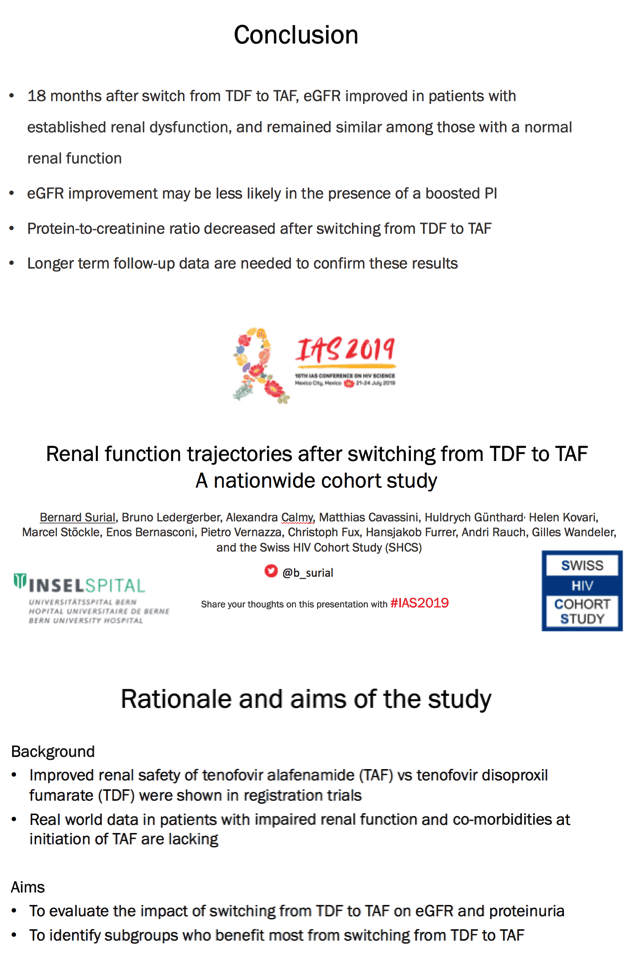
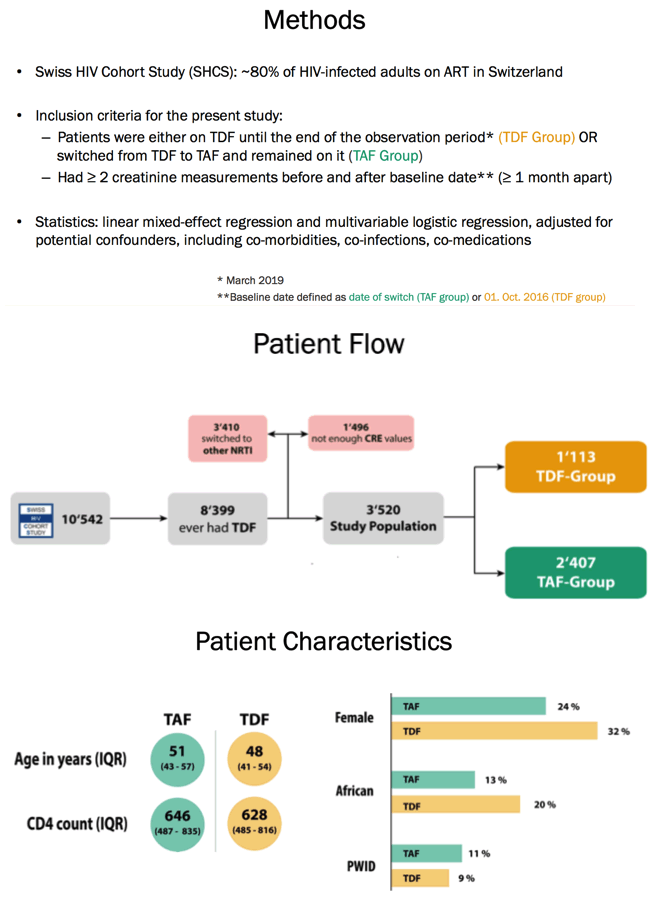
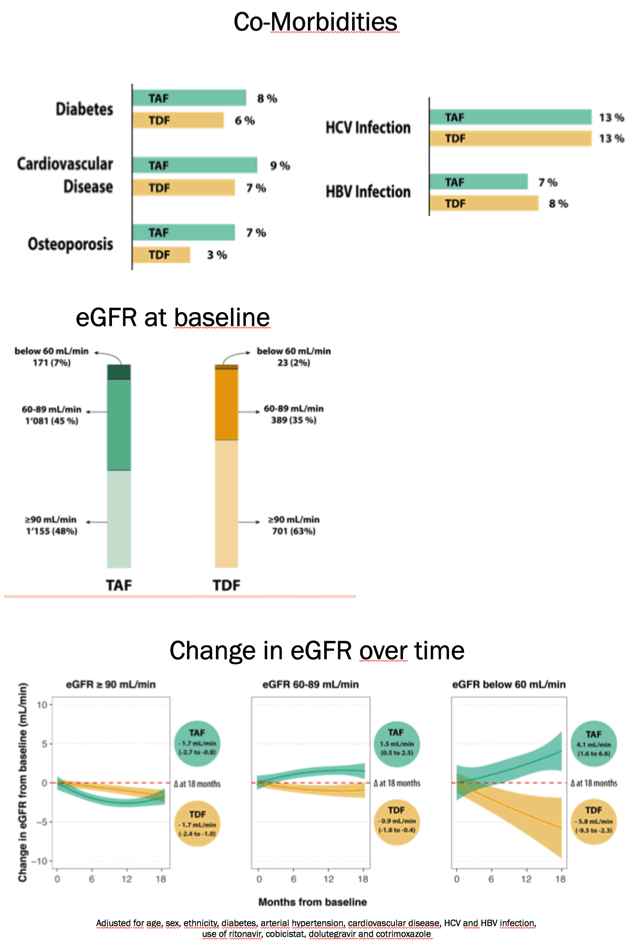
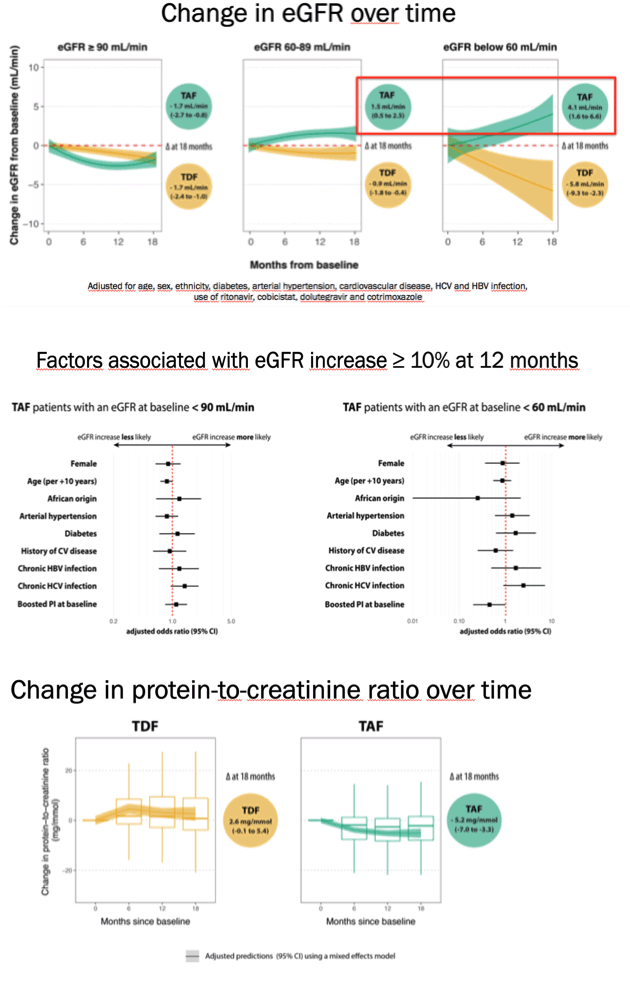
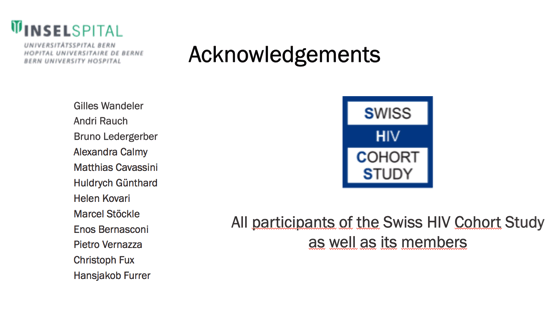
|
| |
|
 |
 |
|
|